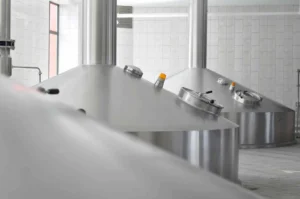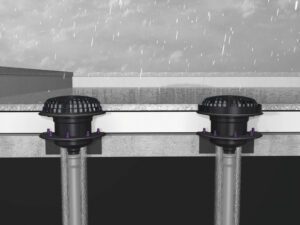As the owner or operator of an above ground liquid storage tank farm, you have a responsibility to implement effective Storage Tank Farm Security measures to protect your facility. There are numerous threats facing tank farms today that require proactive risk management. Given the hazardous and flammable nature of the materials stored onsite, even a minor security breach could have catastrophic consequences, including loss of life, environmental damage, and disruption of operations. Establishing robust security procedures is critical to ensure the safety of your employees, surrounding communities and the environment. By identifying and addressing vulnerabilities, installing appropriate deterrents and barriers, and developing emergency response plans, you can mitigate security risks at your tank farm and prevent potentially disastrous incidents. With diligent threat assessment and the latest protective strategies, your facility can operate securely and safely.
Oil Tank Fuel Line Protection Tips
For effective fuel security and above ground liquid storage facility, physical barriers are essential. Fencing, gates, and bollards can restrict unauthorized access and protect critical infrastructure.
Perimeter Fencing
A perimeter fence around the tank farm establishes a physical barrier against intruders. Chain link or barbed wire fencing, at a minimum height of 6 to 8 feet, is typically used. For added security, install fencing slanted inward at a 45-degree angle, making climbing more difficult. Include warning signs indicating restricted access.

Access Gates
Gates should be placed only at designated entrances, with all other sections of fencing securely fastened to posts set in concrete. Manual or automatic gates must be sturdy, lockable, and monitored by security cameras. Only authorized individuals should have keys or access cards to open gates.
Bollard installation
Install concrete or steel bollards around tanks, pipes, valves and other critical components to prevent vehicle impact. Bollards should be embedded at least 3 to 4 feet deep in concrete foundations. For the highest level of protection, install a double row of bollards with a minimum of 5 to 6 feet of separation.
By implementing robust perimeter fencing, strictly controlling all access points, and protecting key infrastructure with bollards, tank farm owners and operators can significantly mitigate security risks. When combined with other measures like security cameras, lighting, and personnel training, facilities can achieve comprehensive protection of aboveground storage tanks and their contents.
Monitoring Systems: Cameras, Alarms and Access Control
To effectively protect an above ground liquid storage facility, a robust monitoring system is essential. This includes security cameras, intrusion detection alarms, and controlled access points.
Security Cameras
Installing high-resolution security cameras provides 24-hour surveillance of the entire tank farm. Position cameras to monitor all access roads, fence lines, tank shell exteriors, valves and piping, as well as sensitive operational controls. Review and store camera footage in case of an incident.

Intrusion Detection Systems
An intrusion detection system (IDS) uses sensors to detect unauthorised access attempts. Place motion-activated sensors, like infrared beams, along fence lines and access roads. Install contact sensors on gates, doors, valves, and hatches. Connect the IDS to an alarm that alerts personnel if triggered.
Access Control Gates
Controlling access is vital. Install motorized gates, bullet-resistant guard booths, and sally ports at all vehicle entrances. Require identification cards, biometric scans, or keyed entry for all doors and gates. Keep records of all individuals accessing the facility, time of entry and departure, and purpose of visit.
With comprehensive monitoring, detection, and access control measures in place, tank farm operators can identify threats early and respond quickly to mitigate risks. However, technology alone is not enough. Educate employees on security procedures, conduct routine checks and tests of all systems, and practice emergency response plans to be fully prepared in the event of a security breach.
Lighting: Proper Illumination Deters Intruders
Proper lighting is essential for deterring intruders and securing tank farm facilities. Bright lighting eliminates shadows and dark areas where intruders can hide, making them clearly visible to security guards and surveillance cameras.
Perimeter Lighting
Installing high-intensity lighting along the perimeter of the tank farm, including entry and exit points, deters unauthorized access. Motion-activated lights that turn on when movement is detected provide an additional layer of security. For the best results, use LED fixtures that provide wide coverage, minimum 1000 lumens brightness, and a color temperature of at least 5000 Kelvin for maximum visibility.
Tank Lighting
Illuminating tank areas, valves, pipes, and other critical components deters tampering and makes any suspicious activity clearly visible. Mount LED floodlights on tank structures to brightly light the area, especially near access points like valves, pipes and ladders. Motion-activated lights can also be used to detect unauthorized access in these areas.
Proper lighting, combined with security cameras, security guards, fencing, and access control, significantly reduces the risk of intrusion for tank farm facilities. Following industry best practices for lighting and illumination helps create a multi-layered approach to security that leaves no area unseen and no shadow unlit. Deterring intruders through strategic lighting placement and maximum visibility is a simple but highly effective way to help safeguard liquid storage tank assets.
In summary, installing a robust lighting system with motion-activated and high-intensity fixtures along the perimeter and throughout tank areas provides essential protection for aboveground storage facilities. When intruders have nowhere to hide in the light, storage tank farm security is enhanced.
On-Site Security: Having Adequate Personnel Is Key
Adequate security personnel is essential for protecting an aboveground storage tank facility. As the primary line of defense, security guards conduct routine patrols, monitor the facility perimeter and entrance gates, and respond to alarms or suspicious activity. However, many facilities operate with a bare minimum number of guards to cut costs. This puts operations at risk.
Increase Guard Numbers During Peak Times
Facilities should increase security guard numbers during peak operating times or when product levels are highest in the tanks. More guards are needed to properly monitor all access points and tank containment areas. They can also respond faster in the event of an incident.
Provide Ongoing Training
Guards require ongoing training to effectively secure a tank farm. They need to understand facility operations, common threats like theft or vandalism, and emergency response procedures. Refresher courses and drills should be conducted regularly. Guards should also be trained to properly operate security equipment like cameras, motion detectors, and fire suppression systems.
Consider Contract Security or Off-Duty Police
Some facilities hire private contract security guards or off-duty police officers for storage tank farm security. These options often provide higher quality personnel with more advanced training. Contract security firms specializing in industrial sites may also offer K9 patrols, aircraft monitoring, and risk assessment services. Off-duty police officers provide valuable experience responding to criminal activity. Either of these options may incur higher costs but help reduce security risks.
Increase Security During Reduced Operating Hours
Guard numbers and patrol frequencies should increase during times when there are fewer facility personnel onsite, such as nights, weekends, and holidays. With less activity, threats are more easily detected and criminal opportunity increases. More guards and patrols act as a deterrent against intruders or other security risks when operating levels are low.
Implementing these security measures helps ensure adequate personnel coverage, ongoing guard training, and increased protection during off-hours or peak operating times. Together, these best practices mitigate threats, reduce criminal opportunity, and safeguard above ground liquid storage facilities.
Cybersecurity: Protecting Digital Assets in the Tank Farm
To effectively protect tank farm digital assets, several cybersecurity best practices should be implemented.
Network Security
Restricting network access is critical. Use firewalls to control access to the tank farm control system network and isolate it from any corporate networks. Only allow authorized devices and IP addresses to connect.
Enable intrusion detection systems (IDS) to monitor for malicious network traffic and unauthorized access attempts. IDS alerts can detect cyber attacks early. Review logs regularly to identify any ongoing attack efforts.
Access Control
Establish role-based access controls to limit user access to what is required for their job function. Disable any unused access methods like dial-up modems.
Enforce strong, complex passwords that are changed frequently. Consider using multi-factor authentication for an added layer of access control.
System Hardening
Remove or disable any unnecessary software, accounts, and services on tank farm control system devices. Unused programs and open ports provide opportunities for exploitation.
Keep all software up to date with the latest patches to mitigate known vulnerabilities. This includes operating systems, applications, firmware, and all third-party software.
Monitoring and Logging
Continuously monitor tank farm control system networks and devices for anomalies that could indicate a cyber attack. Review logs routinely to identify any unauthorized access attempts or other malicious events.
Maintain audit trails and logs of user activities, network events, and system changes. Log data should be protected and stored for at least 90 to 180 days for analysis and forensic purposes.
Tank farm owners and operators must take a proactive approach to protecting digital assets that control critical infrastructure. Implementing robust cybersecurity practices and controls can help reduce the risk of disruptive cyber attacks on aboveground storage tank facilities. Staying vigilant and keeping security measures up to date as new threats emerge is key.
Security Risk Assessments: Identifying and Addressing Vulnerabilities
Security risk assessments are a critical first step in protecting any tank farm facility. By identifying vulnerabilities and weaknesses in infrastructure, processes, and security systems, owners and operators can implement appropriate countermeasures to mitigate risk.
Physical Site Security Assessment Checklist
A thorough review of the physical site should evaluate:
- Perimeter fencing, lighting, and signage. Inadequate fencing or poor lighting provides opportunities for intrusion.
- Access control points like gates and entrances. These are prime targets for unauthorized access and should be monitored at all times.
- The location and visibility of critical assets like storage tanks, pipelines, and control rooms. Consider relocating or obscuring highly visible targets.
- The proximity of surrounding infrastructure like roads, railways or navigable waterways. Nearby transportation networks provide escape routes and may enable attacks from vehicles.
Tank Farm Cyber Threat Evaluation
With increasing automation and digitalization at tank farms, cyber risks must also be addressed. A cyber assessment should review:
- SCADA and DCS systems for controlling valves, pumps, and monitoring equipment. These offer a tempting target for disruption.
- Any wireless networks, especially if they connect to control systems. Wireless networks are more vulnerable to hacking and interference.
- Employee access to critical IT infrastructure. Only authorized individuals should have access to sensitive control systems and data.
- Backup power systems in the event of power outages from cyberattacks. Loss of power could disable pumping, monitoring and leak detection systems.
By identifying and mitigating physical and cyber risks, tank farm owners and operators can implement robust security strategies to protect their sites, prevent disasters, ensure business continuity and comply with regulations. Security risk assessments provide the foundation for building a comprehensive security management plan.
Conclusion
As the owner or operator of an above ground liquid storage tank farm, your responsibility is to implement prudent security measures to protect your facility. With terrorist threats and risks of theft or vandalism, you must put appropriate safeguards in place. By following industry best practices for storage tank farm security like installing perimeter fencing, monitoring systems, access control, and conducting routine inspections, you can mitigate risks and help ensure regulatory compliance. Protecting critical infrastructure like storage tank facilities requires ongoing vigilance and a comprehensive, multi-layered approach to security. While there is no way to eliminate all risks, with the proper planning and protocols you can reduce vulnerabilities and keep your tank farm and the surrounding community safe. Staying up-to-date with the latest guidelines and technologies in storage tank farm security should be an important part of your risk management strategy.



